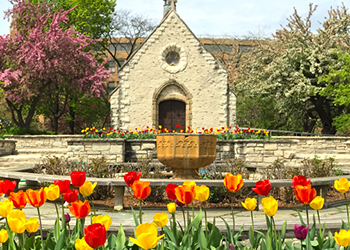Medieval Graffiti at the Chapel
Crystal Hollis has studied medieval graffiti since 2012. While much of her previous work focuses on the UK, the study of this medieval practice led Crystal to investigate the St. Joan of Arc chapel in 2016. This material was first presented to the Way Klingler Teaching Award class, Joan of Arc, Hearken To My Voice in the spring 2017.
When considering the graffiti in the St. Joan of Arc chapel on Marquette's campus, the best place to start is the history of the chapel itself. Originally built in the 15C in Chasse France, it was attached to a chateau and used both privately and publicly for events such as burials, weddings, and of course, mass. After being a functioning place of worship for several hundred years it fell out of use and eventually into a state of decay around the time of the French Revolution. Around this time it is thought that the records from the chapel were lost. The chapel was originally dedicated to St. Martin de Sayssuel, though some claim it was dedicated to St. Martin de Chasse — both represent the local region the chapel is from.
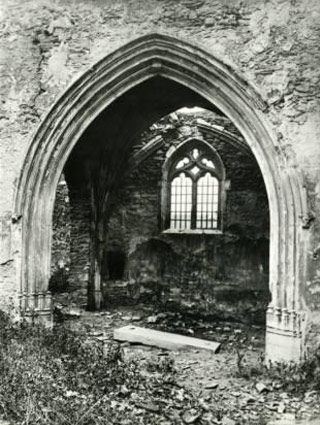 In the 1920's, an architect by the name of Jacques Couelle found the chapel and began to record and number the stones in the hopes of restoring it. The village of Chasse sold the chapel to him, and he sold the chapel to Gertrude Hill Gavin for use at her Long Island estate and to be attached to a previously reconstructed chateau. Several changes were made to its construction: the sacristy was moved, an altar was added, stained glass windows were installed, the Joan of Arc stone was added to the niche, and a renaissance era tabernacle was installed.
In the 1920's, an architect by the name of Jacques Couelle found the chapel and began to record and number the stones in the hopes of restoring it. The village of Chasse sold the chapel to him, and he sold the chapel to Gertrude Hill Gavin for use at her Long Island estate and to be attached to a previously reconstructed chateau. Several changes were made to its construction: the sacristy was moved, an altar was added, stained glass windows were installed, the Joan of Arc stone was added to the niche, and a renaissance era tabernacle was installed.
In the 1960's the estate was taken over by the Rojtman family. However, before the Rojtman's were able to move into the estate a fire broke out and destroyed or damaged most of the buildings. Portions of the chateau were given to the Metropolitan Museum of Art and now reside in the cloisters collection. The chapel and all its contents, however, were donated to Marquette University under the condition that it would be used for worship – and it is still being used for daily mass today. Stone by stone, the chapel was disassembled and marked with a red spot on the bottom, a green spot on top, and number for identification.
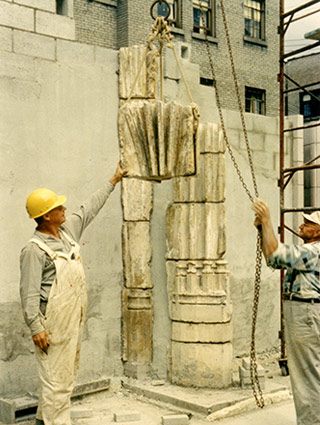 The reconstruction took place in 1965, and the chapel was rededicated to St. Joan of Arc. More architectural changes were made – the sacristy moved back to its original position, the tomb covering moved to the left of the altar, and most importantly the nave (where students often sit for mass or prayer) expanded the chapel to accommodate up to 150 people.
The reconstruction took place in 1965, and the chapel was rededicated to St. Joan of Arc. More architectural changes were made – the sacristy moved back to its original position, the tomb covering moved to the left of the altar, and most importantly the nave (where students often sit for mass or prayer) expanded the chapel to accommodate up to 150 people.
Going to the chapel today, you will see the stones which are weathered and clearly very old. The angel corbels on either side of the arch are the most obvious examples – their faces and finer features are worn away. Looking at the arch itself you can also see remnants of paint from when the chapel was originally in France (in the medieval period chapels and places of worship were brightly painted, often with scenes from the Bible), as well as various scraping marks from the reconstructions. The presence of graffiti in a building like this would not typically be expected, from an architectural and archaeological standpoint the building has simply been through 'too much' to expect any good examples of medieval graffiti.
But before we approach the graffiti in the chapel, what is medieval graffiti?
In the medieval era graffiti was a widely practiced and socially acceptable occurrence. It was practiced by both rich and poor alike (we know this because we have recorded inscriptions that are both crudely executed text and others that are beautifully and ornately drawn text indicating names of the wealthy) and each graffitio has a unique meaning or purpose — in the case of the chapel the purpose is spiritual. We can tell this was acceptable as we find graffiti in large quantities in so many buildings, it is obvious that this was a regular and common practice. There are several different kinds of graffiti — and a basic classification system does exist (see the links at the end of this essay). There are figures, animals, shoes, text, mason's marks, and apotropaic graffiti just to name a few. As the kind of graffiti in the St. Joan of Arc chapel are apotropaic, we'll discuss those and what they mean.
There are several kinds of apotropaic (protective or 'anti-evil spirit') graffiti, the most popular being a concentric circle design known as a hexfoil (more commonly referred to as a daisy wheel). These are found all over churches and other historic buildings in Europe. It was formerly thought they were designs used as teaching tools by master masons to demonstrate the basics of geometry to their students, however, masons compasses are far too large to have made the vast majority of recorded hexfoils today. The other most popular kind of apotropaic graffiti is what looks like a W but is actually two intersecting V's that serve the purpose of invoking the Virgin Mary. Oddly enough, neither of these kinds of graffiti are present in the chapel.

The kind of apotropaic graffiti present in the chapel are two less common designs. The first is the ladder, which is represented by a vertical line intersected by several horizontal lines. There are a few instances of this design the the St. Joan of Arc chapel on the back of the right side of the chancel arch. Ladders symbolize climbing up and away from evil and sin, and are commonly associated with the Old Testament Bible story of Jacob's ladder. The other image that is present in the chapel that is not commonly found is the pentangle — or the five pointed star. Though commonly associated with neo-paganism today, the pentangle was considered a protective and Christian symbol. 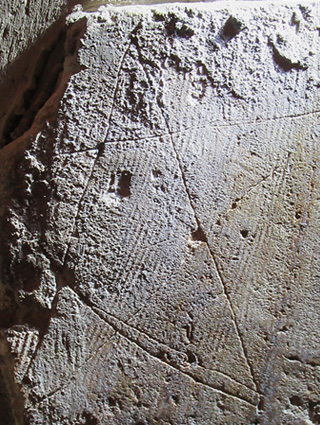 Evidence of this can be found in the medieval text Gawain and the Green Knight, where Sir Gawain prepares to ride out on his quest and a detailed description of his armor is given. For our purposes, the description of the gold five pointed star which symbolized the five senses, the five joys of Mary, and the five wounds of Christ is most important from this passage, it gives us a concrete meaning to attach to the symbol. The pentangle also follows the premise of Solomon's Knot or the never ending line – where a line intersects itself several times but never truly ends. Designs such as these were thought to distract and trap evil spirits, as they would start to follow the line and never be able to find their way out as the line never ended. On the same slab you will notice a seven pointed star – which is also by comparison not a common symbol. Again, this symbol invokes the premise of the never ending line, just with a different number of points (seven instead of five).
Evidence of this can be found in the medieval text Gawain and the Green Knight, where Sir Gawain prepares to ride out on his quest and a detailed description of his armor is given. For our purposes, the description of the gold five pointed star which symbolized the five senses, the five joys of Mary, and the five wounds of Christ is most important from this passage, it gives us a concrete meaning to attach to the symbol. The pentangle also follows the premise of Solomon's Knot or the never ending line – where a line intersects itself several times but never truly ends. Designs such as these were thought to distract and trap evil spirits, as they would start to follow the line and never be able to find their way out as the line never ended. On the same slab you will notice a seven pointed star – which is also by comparison not a common symbol. Again, this symbol invokes the premise of the never ending line, just with a different number of points (seven instead of five).
Despite the occurrence of the wonderful inscriptions in the chapel, it is likely there were many more that were lost either to exposure to the elements or reconstruction. The original stones of the building show several kinds of modern tooling marks — that is evidence of modern 'cleaning up' with masonry tools. The combing marks that cover the arch are also from modern tools — and these are likely what would have destroyed most of the graffiti that would have been present. At the time of both reconstructions medieval graffiti was not an area of study or part of archaeological surveys, in fact no one really knew what it was! So when considering the potential loss of more graffiti we must remember that their probable destruction was accidental.
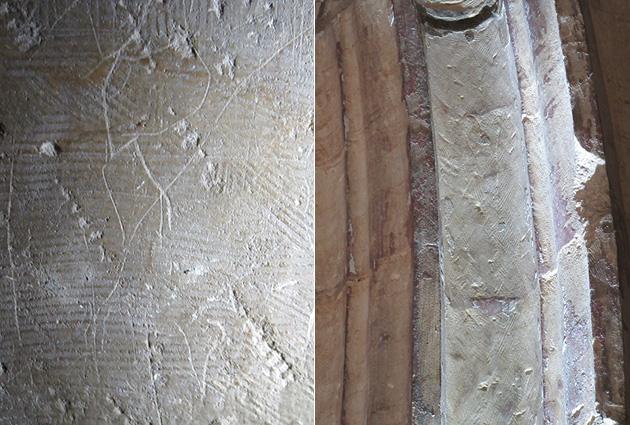
The graffiti present in the St. Joan of Arc chapel are truly unique. Not only have they survived decay, a transatlantic move, and two reconstructions, but they are the only European medieval graffiti in the United States that are in their original context. Meaning they are in the place they would have been hundreds of years ago, and to make the find even more special — the building is used for its original purpose from hundreds of years ago. Marquette University hosts not only the treasure that is the chapel itself, but the treasure within the treasure — medieval graffiti from its original French home — a small reminder of its use and importance as a place of worship through the centuries.
Resources
Norfolk Medieval Graffiti Survey
This survey is the largest and longest running in the UK. It has recorded thousands of inscriptions and has excellent resources for getting started in the study of medieval graffiti
English Medieval Graffiti — Violet Pritchard
One of the earlier sources available on the subject, this book is at times now inaccurate but an essential read for anyone who is interested in graffiti. Different regions, types, and several buildings are written about which gives a very good scope of the field.
Medieval Graffiti: The Lost Voices of England's Churches — Matthew Champion
Recently published, this book goes into more detail of different kinds of graffiti and their meanings and uses.
Recording a Church: An Illustrated Glossary — Thomas Cocke
Small but handy resource for learning the parts of the church and other architectural terms that may help when reading other materials concerning graffiti – or even if visiting a church and recording them on your own!
 In the 1920's, an architect by the name of Jacques Couelle found the chapel and began to record and number the stones in the hopes of restoring it. The village of Chasse sold the chapel to him, and he sold the chapel to Gertrude Hill Gavin for use at her Long Island estate and to be attached to a previously reconstructed chateau. Several changes were made to its construction: the sacristy was moved, an altar was added, stained glass windows were installed, the Joan of Arc stone was added to the niche, and a renaissance era tabernacle was installed.
In the 1920's, an architect by the name of Jacques Couelle found the chapel and began to record and number the stones in the hopes of restoring it. The village of Chasse sold the chapel to him, and he sold the chapel to Gertrude Hill Gavin for use at her Long Island estate and to be attached to a previously reconstructed chateau. Several changes were made to its construction: the sacristy was moved, an altar was added, stained glass windows were installed, the Joan of Arc stone was added to the niche, and a renaissance era tabernacle was installed. The reconstruction took place in 1965, and the chapel was rededicated to St. Joan of Arc. More architectural changes were made – the sacristy moved back to its original position, the tomb covering moved to the left of the altar, and most importantly the nave (where students often sit for mass or prayer) expanded the chapel to accommodate up to 150 people.
The reconstruction took place in 1965, and the chapel was rededicated to St. Joan of Arc. More architectural changes were made – the sacristy moved back to its original position, the tomb covering moved to the left of the altar, and most importantly the nave (where students often sit for mass or prayer) expanded the chapel to accommodate up to 150 people.
 Evidence of this can be found in the medieval text Gawain and the Green Knight, where Sir Gawain prepares to ride out on his quest and a detailed description of his armor is given. For our purposes, the description of the gold five pointed star which symbolized the five senses, the five joys of Mary, and the five wounds of Christ is most important from this passage, it gives us a concrete meaning to attach to the symbol. The pentangle also follows the premise of Solomon's Knot or the never ending line – where a line intersects itself several times but never truly ends. Designs such as these were thought to distract and trap evil spirits, as they would start to follow the line and never be able to find their way out as the line never ended. On the same slab you will notice a seven pointed star – which is also by comparison not a common symbol. Again, this symbol invokes the premise of the never ending line, just with a different number of points (seven instead of five).
Evidence of this can be found in the medieval text Gawain and the Green Knight, where Sir Gawain prepares to ride out on his quest and a detailed description of his armor is given. For our purposes, the description of the gold five pointed star which symbolized the five senses, the five joys of Mary, and the five wounds of Christ is most important from this passage, it gives us a concrete meaning to attach to the symbol. The pentangle also follows the premise of Solomon's Knot or the never ending line – where a line intersects itself several times but never truly ends. Designs such as these were thought to distract and trap evil spirits, as they would start to follow the line and never be able to find their way out as the line never ended. On the same slab you will notice a seven pointed star – which is also by comparison not a common symbol. Again, this symbol invokes the premise of the never ending line, just with a different number of points (seven instead of five).
